Beyond North Korea: Possible Sources of Small Arms and Light Weapons Exports to Russia in 2022?
As Russia’s “special military operation” in Ukraine persists, Moscow strives to secure enough military equipment for the Russian troops in Ukraine. The shortage of weapons in the conflict also links to the allegation that North Korea is covertly supplying artillery shells to Russia, although North Korea’s export of small arms and light weapons (SALW) is currently banned under United Nations (UN) Security Council Resolutions, regardless of who the importer may be. Russia is seemingly willing to ignore these sanctions in the will to achieve its own military goals. But certainly, Pyongyang cannot be the only supplier of SALW to Russia. In fact, the UN trade database shows 19 countries have transferred SALW to Russia in 2022, including 12 members of the European Union (EU) and seven non-EU countries.
 Given that arms transfers are driven not only by economic interest but also by political interest, understanding the current supply chains involved in the conflict in Ukraine can help scope out a reshaped political network in a post-conflict era that could be exploited by North Korea in future sanctions evasion attempts.
Given that arms transfers are driven not only by economic interest but also by political interest, understanding the current supply chains involved in the conflict in Ukraine can help scope out a reshaped political network in a post-conflict era that could be exploited by North Korea in future sanctions evasion attempts.
Allegations of North Korean Transfers to Russia
The UN trade database does not offer any indications that corroborate the alleged arms transfer to Russia by North Korea between 2022 and 2023. Indeed, it only shows that Poland is the sole country that traded SALW with North Korea in 2022. Therefore, verifying claims of Russian sanctions violations via the trade database is a difficult task since North Korea does not report its national import and export data to the UN, and provision of such data is at the discretion of states including Russia, which could possibly mean certain illicit trading activities are left out of the officially declared data.
North Korea’s political and economic ties with Russia and potentially some of the non-EU partners currently exporting to Russia could be strengthened if the ongoing conflict ends favorably for Russia and therefore should be monitored closely.
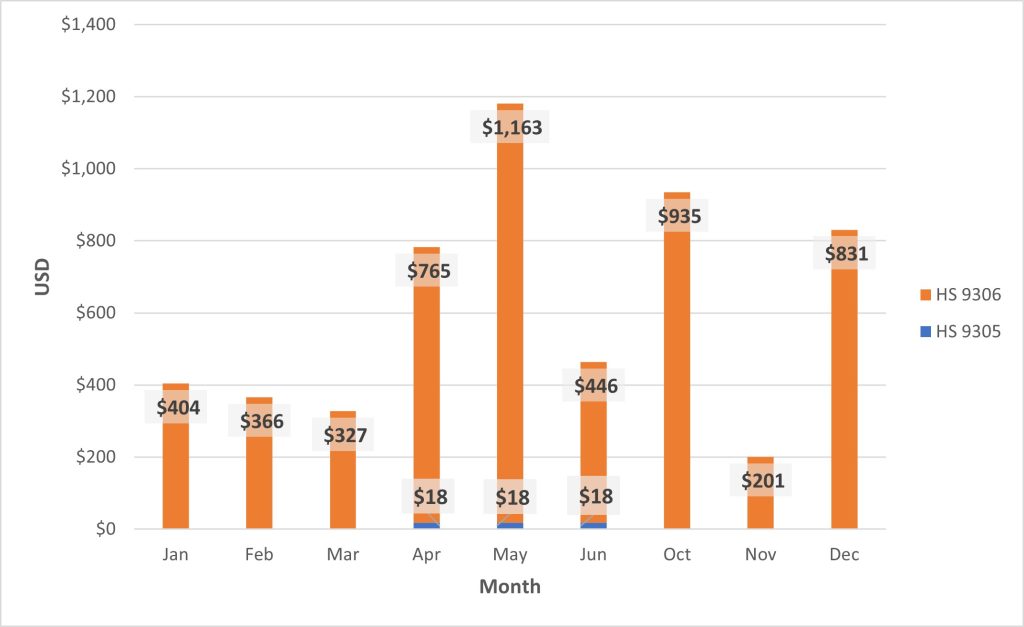
Tracking Russia’s Other Partners
The UN trade database, UN ComTrade, is constructed with tariff nomenclature codes, called Harmonized System (HS) codes, which roughly identify the types of commodities traded by UN Member States. As shown in Figure 2, traded items reported under the nomenclature code HS 93 are generally understood as being SALW, while its coverage also includes civilian arms, such as hunting rifles and guns for competition and sword-like weapons. For this reason, it is important to note that the findings in this article do not constitute conclusive evidence of military-related transactions involving Russia and thus require further investigation. Given the characteristics of modern wars, sword-like weapons were excluded from the analysis.
Who Has Exported SALW to Russia?
Immediately after Russia invaded Ukraine in February 2022, the total exports of SALW to Russia significantly decreased from about 5.5 million USD to roughly 768,000 USD in March 2022. Since then, SALW exports have increasingly gained momentum, amounting to about 2.6 million USD in September 2022. While the total exports of SALW to Russia plunged to 69,868 USD in October 2022, the SALW sales to Russia skyrocketed to about 9.7 million USD in November 2022.
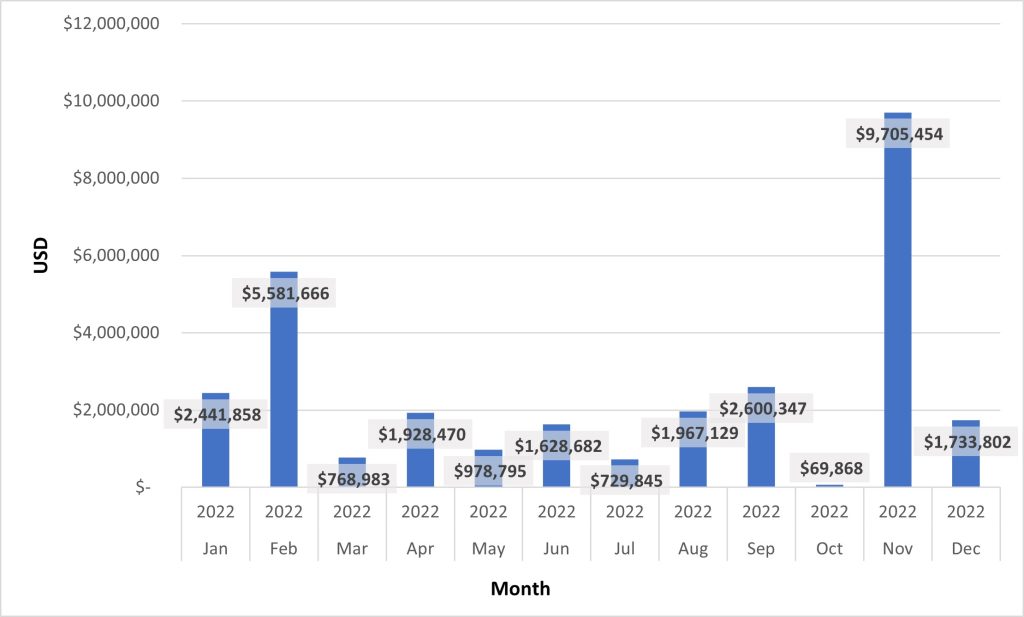
Nineteen states exported SALW to Russia between January 2022 and December 2022. The identified suppliers include several Member States of the EU, although the total trade volume has considerably decreased since March 2022. It is noteworthy that such SALW exports were made amidst the EU arms embargoes imposed on Russia since 2014 in response to the Crimea crisis. Meanwhile, Russia's reliance on non-EU countries for arms procurement has recently increased significantly, which may contribute to Russia's capability to sustain its ongoing war with Ukraine.
The European Union
The overall trends of SALW exports by the EU significantly decreased from approximately 3.6 million USD in February 2022 to about 325,000 USD in March 2022. Since then, monthly SALW exports to Russia have been capped at less than 500,000 USD. In 2022, 12 EU members— Belgium, Denmark, Estonia, Finland, Germany, Italy, Latvia, Lithuania, Netherlands, Poland, Slovakia and Sweden—exported SALW to Russia. While one of the country’s major suppliers, Italy, stopped its SALW sales to Russia since the outbreak of the conflict in February 2022, the database suggests that Germany, Estonia, Latvia, and Lithuania continued to supply SALW to Russia.
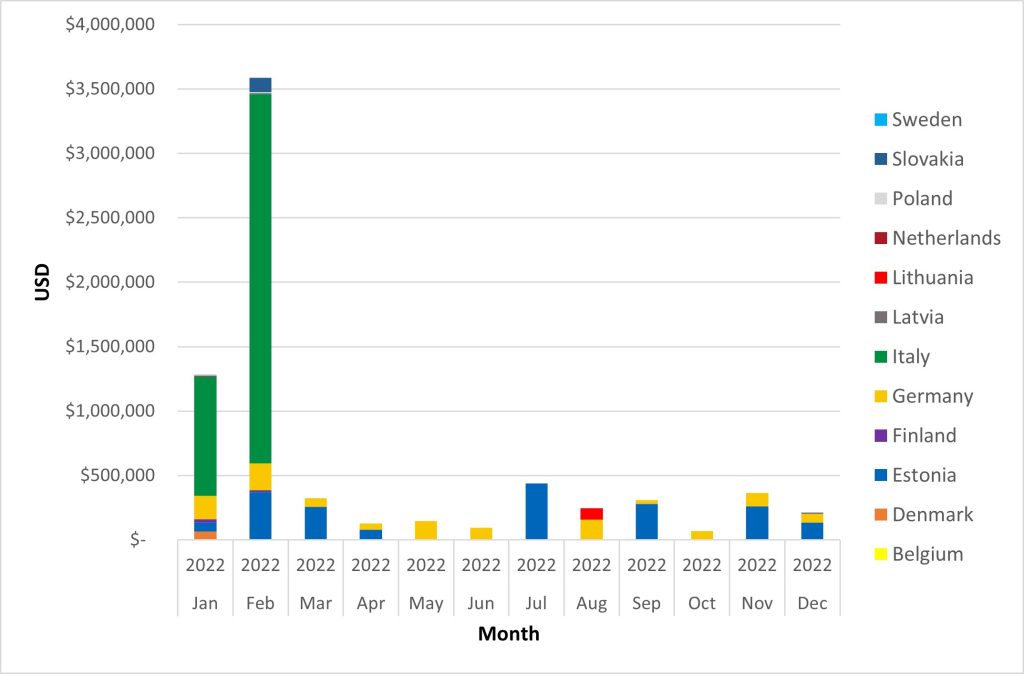
Non-EU States
Shortly after the outbreak of the war in February 2022, SALW exports by non-EU countries decreased from about 2.36 million USD to roughly 443,000 USD. Russia’s SALW imports from non-EU countries maintained a volatile but general recovery trend that peaked at 9.3 million USD in November 2022. No data concerning non-EU countries exists for October 2022. A total of seven countries exported SALW to Russia in 2022. These countries were China, India, New Zealand, Serbia, Switzerland, Turkey and the United States. Since March 2022, two non-EU countries, India and Turkey, have exported substantial amounts of SALW to Russia.
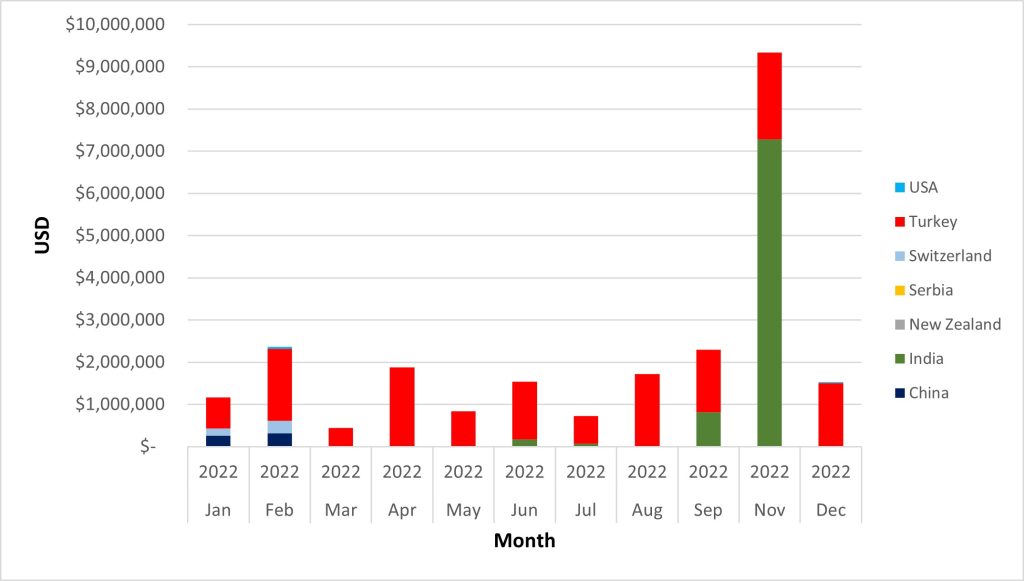
SALW Exported to Russia
The EU exported a broad range of SALW to Russia until February 2022. However, about 70% of the items that the EU exported since the outbreak of war fall under the tariff nomenclature code 9306, which classifies goods as bombs, grenades, torpedoes, mines and missiles. Roughly 30% of exports are arms that do not involve explosives, such as pistols and rifles that employ compressed air or spring mechanisms. Meanwhile, non-EU exports in 2022 cover various types of SALW. Approximately 44% of non-EU exports are items potentially related to bombs, grenades, torpedoes, mines and missiles, mostly driven by India’s 7.2 million USD of exports in November 2022. Roughly 54% of non-EU exports are gun-type weapons, including firearms and guns that do not use explosives.
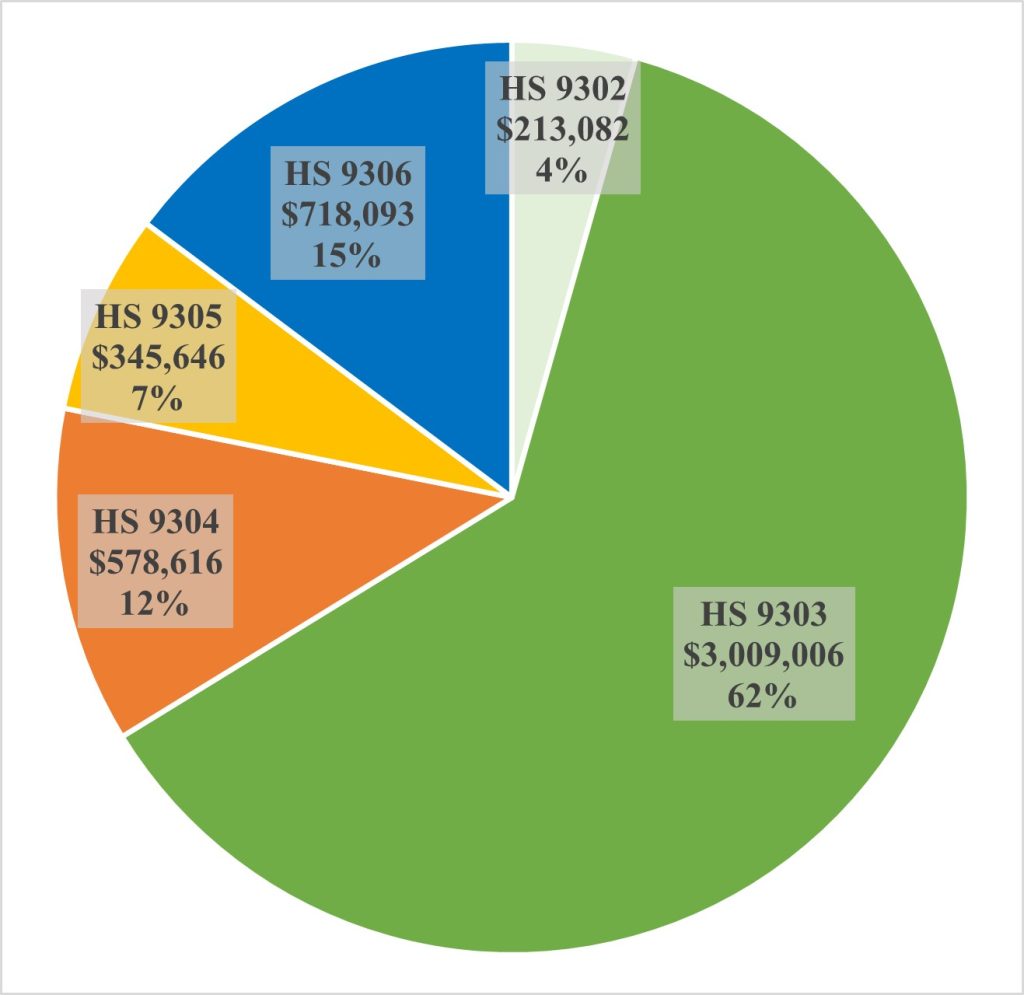
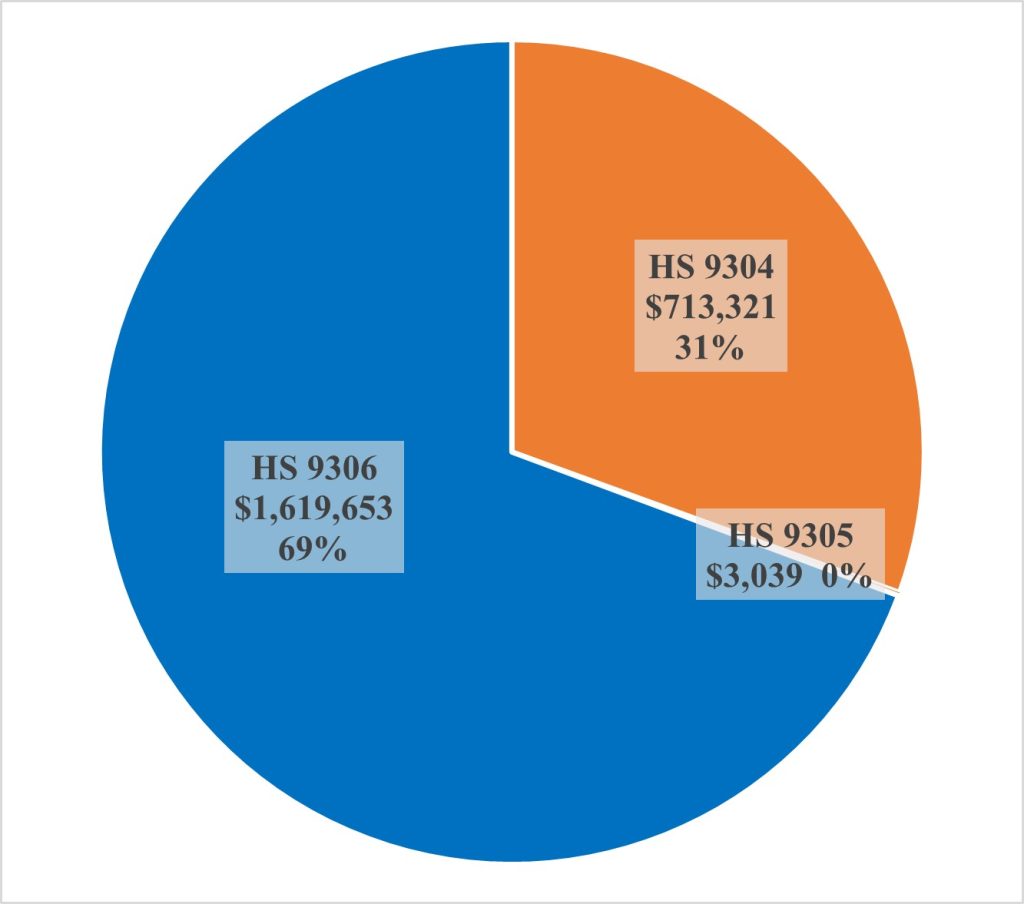
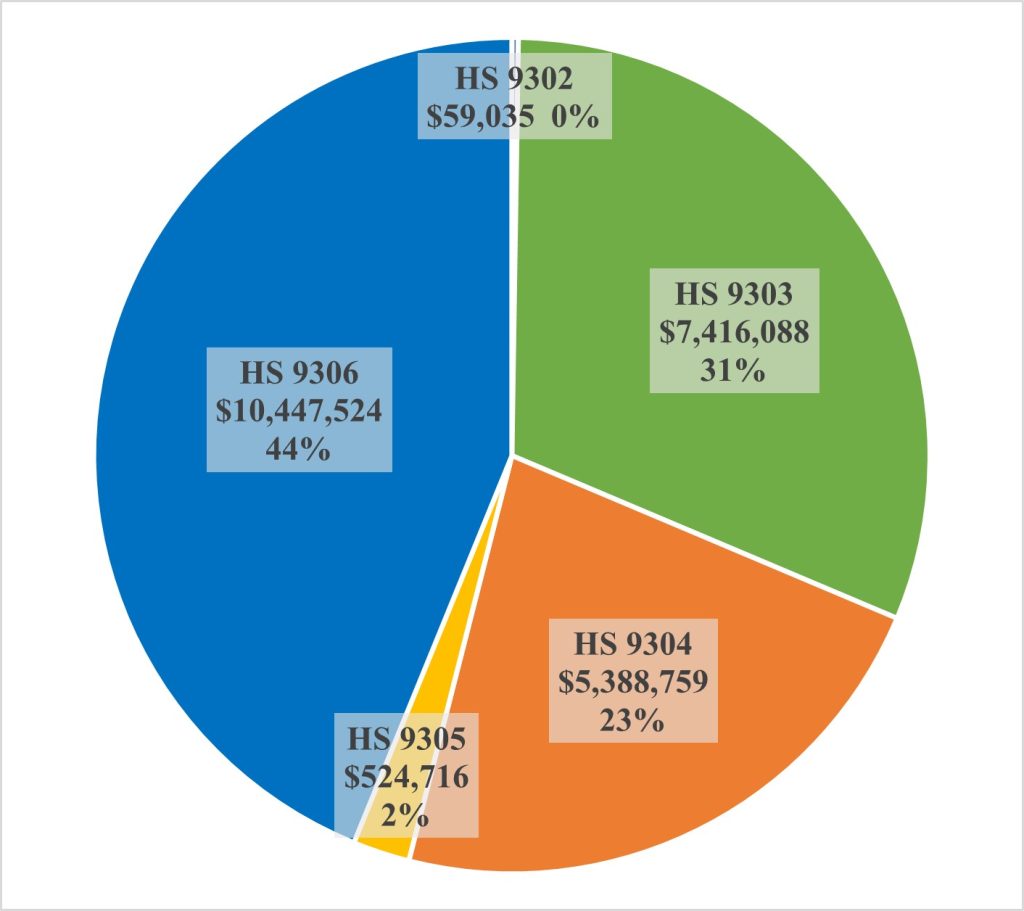
Indications of SALW Exports to Russia in the UN Database
There are several reasons why the UN database indicates that there are SALW exports to Russia happening. First, the exporters may have made mistakes in classifying non-SALW items as SALW. This is because the export classification process mainly depends on the exporter's discretion. Therefore, if exporters have misclassified their exported items, the UN database may also contain datapoints indicating transactions involving items that were misclassified as being SALW. In addition, exporters may have made mistakes in declaring the destination or origin of items by confusing South Korea with North Korea.[1]
Second, some EU Member States may have varying interpretations of the definition for “arms and related materiel of all types,” stated in the EU restrictive measures on Russia adopted in 2014. Specifically, small firearms or arms not designed for direct military purposes, such as guns for competition or animal hunting or mock grenades for training, may not be seen as military items. Some EU Members may view those items as not being subject to the EU's sanctions on Russia. For example, China claimed that it does not consider arms for civilian purposes as being subject to the sanctions on North Korea in response to the UN Panel of Experts' inquiry about the UN database, which indicates that China exported SALW to North Korea. In October 2022, the EU clarified that firearms, related parts and ammunition are prohibited from exporting to Russia.
Third, there is a view that EU Member States have exploited a “loophole” in the EU arms embargo on Russia. Specifically, the EU regulation concerning the 2014 arms embargo on Russia contained a grandfather clause that allowed EU Members to export weapons to Russia for contracts concluded before August 2014. In April 2022, the EU revised the regulation to remove such exceptions. Therefore, the UN database may include occasions in which EU Member States exported SALW or other related parts to fulfill their contracts before August 2014.
Fourth, some EU states might have knowingly or unwittingly transferred SALW to Russia via a third country. For instance, the database indicates that the type of transfers made by Estonia in February, April and July of 2022 were reexports, which means that Estonia imported SALW from a third party to Estonia and then transferred them to Russia. To be more specific, the reexport cases of April and July involve bombs, grenades, torpedoes, mines and missiles. According to the UN database, the countries that exported such items to Estonia in 2022 include: Belgium, Brazil, Czech Republic, Denmark, Finland, Germany, Italy, Sweden, Poland, Latvia, Lithuania, the United Kingdom, the Netherlands, the United States, Spain, Luxembourg, Switzerland and Turkey. In other words, Estonia might have imported items falling under HS 9306 from either EU Member States or non-EU states and then transferred them to Russia.
Lastly, some countries, especially non-EU states, may not only have economic interests, but also political interests in engaging with Russia. Arms exports reflect not only an economic interest, but also foreign policy direction. The EU has consistently condemned Russia’s “illegal annexation” of Ukraine’s Donetsk, Kherson Luhansk and Zaporizhzhia regions. This means that the exports of SALW by some EU Members might not have stemmed from political interest. Meanwhile, there is a view that Turkey intends to expand its regional influence by acting as a mediator between Western and non-Western countries. In addition, India also wants to uphold its independent foreign policy by maintaining a friendly relationship with Russia. Therefore, Turkey and India’s SALW support for Russia could be a part of their foreign policy agenda and in their economic interest.
Conclusion
The open-source information suggests that both Western and non-Western countries exported SALW to Russia in 2022, albeit with varying trends regarding the total volumes of their actual trading. Some EU Member States have exported SALW to Russia since 2014 regardless of the restrictive measures the EU has in place. Although the grandfather clause/loophole in the EU arms embargo was closed in April 2022, a few EU Member States continued their exports of SALW—especially items such as bombs, grenades, torpedoes, mines, missiles and other similar munitions—to Russia until December 2022. Meanwhile, Russia's reliance on non-EU countries, especially those having political interest in maintaining a relationship with Russia, for SALW procurements continued in 2022 with a peak in November 2022.
Since arms trades involve political considerations beyond economic interest, the contemporary great power competition may have strengthened political ties between Russia and some non-EU states, such as India, Turkey, and North Korea. If the conflict in Ukraine ends up significantly affecting the current international order upheld by the US and its Western allies, the possibility of having constructive and peaceful cooperation with North Korea may dwindle. North Korea’s grievance of Western “double standards” may intensify if Pyongyang perceives the EU as economically benefitting from Russia’s ‘special operation’ which it morally and legally criticizes. Moreover, under Russia's political and economic support, North Korea may exhibit a more provocative and bolder stance which could undermine the regional stability in East Asia.
From the sanctions perspective, it might be necessary to reach out to India and Turkey to ensure that their ties with Russia do not affect their implementation of the sanctions on North Korea in a post-conflict era while requesting the EU to stop sales of SALW, especially mines, torpedoes, grenades, and missiles, to Russia to limit Russia’s war sustaining capability.
- [1]
See Annex 62 of S/2023/171. https://undocs.org/Home/Mobile?FinalSymbol=S%2F2023%2F171&Language=E&DeviceType=Desktop&LangRequested=False
